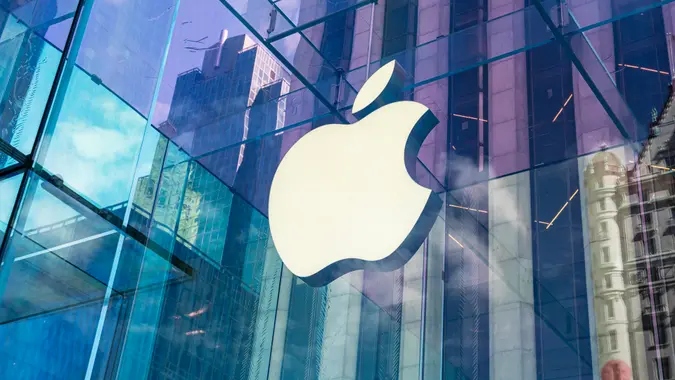Could You Retire Today If You Had Bought Apple Stock 10 Years Ago?

Commitment to Our Readers
GOBankingRates' editorial team is committed to bringing you unbiased reviews and information. We use data-driven methodologies to evaluate financial products and services - our reviews and ratings are not influenced by advertisers. You can read more about our editorial guidelines and our products and services review methodology.

20 Years
Helping You Live Richer

Reviewed
by Experts

Trusted by
Millions of Readers
Apple stock is one of the “magnificent seven,” a term applied to tech stocks whose growth has outperformed the S&P 500. Those gains are significant, but are they enough that if you had bought Apple stock 10 years ago, you could retire today?
That depends on the numbers. We threw together a couple scenarios to see if you could be retiring comfortably on Apple stock if you were lucky enough to buy in a decade ago.
The Price of Apple Stock in 2015
A decade ago, Apple stock was trading between $24 and $25 per share (in split-adjusted terms). Since then, Apple has had several stock splits, which has greatly increased the size of returns for long-term shareholders. A stock split is when a company increases the number of its shares while lowering the price of each share proportionally, so the total value of your investment stays the same. This can be a psychological move as much as a financial one — removing barriers to trading high-priced stocks.
So, let’s assume you invested $10,000 in Apple stock a decade ago. The math works out to purchasing around 416 shares with your $10,000 (this doesn’t count transaction or broker fees). That $10,000 would today be worth around $100,000 if dividends were reinvested (we’re rounding up to make the math simple).
Could That Fund a Retirement?
While $100,000 would not fund a retirement alone, it certainly could give you a nice slush fund to draw upon, assuming you had other retirement funds.
For example, if you withdrew from your $100,000 by the common 4% withdrawal rule, you could take out $4,000 per year, which could pay for some expenses but it wouldn’t be enough to live on. Probably better to leave that money invested, to keep reaping the benefits of compound interest and further stock splits.
To generate something closer to a modest yearly income, say $40,000 per year, you’d need a portfolio of around $1 million. To have gotten to $1 million from Apple alone over 10 years, at $24/share, you’d have needed roughly 41,666 shares able to grow (with reinvested dividends and splits) to $1,000,000. So, if you’d invested around $100,000 in Apple a decade ago and held through splits and dividends, that might have put you at roughly a $1 million portfolio today, enough for a modest retirement income.
Don’t Put All Your Eggs in One Stock
Reading these figures today could inspire someone to move a huge chunk of their investments into Apple today, but this could be a bad move, despite its performance, according to Chloe Elise, CEO and financial education expert at Deeper Than Money.
“Even when you’re looking at a strong investment, there’s a lot of risk to put all your eggs in one basket… singular companies fluctuate all the time, and even strong companies have ended up going bankrupt or closing.”
What To Do Instead
Instead of trying to bank on a high-performing stock, Elise insisted, “Have a diversified portfolio. It’s as simple as that.” You can allocate a small portion of your investments into companies you feel passionate about or that you see growing, but don’t bet your entire retirement account on it, she urged. “Diversification allows for your portfolio to grow strongly even if a specific company takes a hit.”
Don’t Live in Regret
If you didn’t invest in Apple stock 10 years ago, don’t give yourself a hard time. Elise said, “Just like how you can’t accurately predict today what company will be a top performer 10 years from now, you can’t blame your past self for not knowing that.” She assured that there are many strategies to achieve retirement that don’t require you to make a lucky stock pick.
For most people, a more diversified portfolio plus a mix of income streams is a safer path to a sustainable retirement.
 Written by
Written by  Edited by
Edited by 























